People often ask me for camera recommendations for their travels. It’s a common question, and for good reason. Capturing memories beautifully is a key part of any trip. So, I decided to put together a comprehensive guide outlining the essential features for a travel camera and recommend what I believe are the best options currently available. This guide will cover both the best mirrorless Cameras For Travel and the best compact cameras for travel, ensuring you find the perfect fit for your needs.
Updated for 2024: This article was initially written in 2018, and I’ve revisited it in 2024 to check for new cameras that might surpass my original recommendations. However, the Panasonic GX85 remains the top choice for travel even today. The Canon compact camera recommendation has been updated to the latest model in its series, ensuring you get the most current and effective options.
A great travel camera needs to be versatile, adaptable to various shooting scenarios, and, crucially, easy to carry around. While the ideal camera might slightly vary based on your travel style, the core requirements remain consistent. Considering the features that are most beneficial for travelers, what truly stands out as the best camera for travel in 2024?
If you are eager to know my top recommendation right away, jump directly to the recommended camera section!
Take me to the Best Camera for Travel in 2024
Or, continue reading to understand the key factors in choosing the perfect travel camera for you.
This post contains affiliate links. As an Amazon Associate, I earn from qualifying purchases. The opinions expressed here are entirely my own.
Why Consider Switching from Your Smartphone for Travel Photography?
When friends ask for camera advice, especially if they are accustomed to using their smartphones, my first question is always, “Why are you thinking of switching?”
This question is crucial because if someone is already comfortable with the convenience of a smartphone, there needs to be a compelling reason to carry a separate, larger camera. Otherwise, the new camera might end up unused at home.
Smartphone cameras have made incredible strides in recent years. Interestingly, it’s the software within smartphones that powers features often exceeding those of dedicated cameras. Think of excellent in-camera HDR, seamless panoramas, effortless GPS tagging, and immediate social media sharing capabilities.
Smartphone cameras leverage impressive software to achieve outstanding results.
Here’s an example of a panorama I captured with my husband’s iPhone. Even though I had my Canon 70D DSLR with me, the iPhone made capturing panoramas significantly easier.
Exposure: 1/900s ƒ/2.2 @ ISO 100
Focal Length: 4.15mm
Camera: iPhone SE
Date & Time: April 10, 2017, 7:17 pm
There’s a popular and accurate saying: “The best camera is the one you have with you.” And in today’s world, that’s most likely your smartphone.
However, if you’re researching the best travel cameras, it’s likely you’ve already decided that you’re ready for an upgrade.
Recognizing the Need for a Dedicated Travel Camera
My next question to someone considering a dedicated camera is usually, “What do you plan to photograph?”
For many, the motivation might be capturing precious moments like a new baby, a child’s sporting events, or family gatherings. However, given that this is a travel photography website, I’ll focus this discussion specifically on the best cameras for travel.
Exposure: 1/15s ƒ/11 @ ISO 500
Focal Length: 109mm
Camera: Canon EOS 70D
Date & Time: September 29, 2016, 5:54 pm
What Makes a Camera Ideal for Travel?
Certain features are universally important in any camera, but the priorities shift slightly when it comes to travel. Portability and versatility become paramount.
There’s no single “perfect” camera for every situation, but there is one that can capably handle most of your travel photography needs. You need a camera that can capture stunning landscapes but also zoom in to capture distant details.
 Toucan photographed in Tikal, highlighting the need for zoom capability in travel cameras
Toucan photographed in Tikal, highlighting the need for zoom capability in travel cameras
Exposure: 1/100s ƒ/6.3 @ ISO 400
Focal Length: 135mm
Camera: Canon EOS DIGITAL REBEL XTi
Date & Time: September 29, 2015, 11:41 am
Beyond the type of photography, your comfort level with technology also matters. For someone less tech-savvy, a simpler camera is preferable compared to what I might recommend for a friend who enjoys gadgets.
As an advanced amateur photographer who enjoys manual settings, shoots in raw, and processes photos in Lightroom, my recommendations will align with this perspective. I aim to provide suggestions that are adaptable to various user levels.
Key Features to Consider When Choosing a Camera for Travel
Let’s discuss the critical features for a travel camera and the trade-offs involved. I’ll define each feature and then evaluate how my top camera choices measure up against these criteria. The best cameras for travel should perform well across all these aspects.
Sensor Size: The Heart of Image Quality
Sensor size is a critical factor. Generally, a larger sensor equates to better image quality. Think of the sensor as the digital equivalent of “film” in your camera; its size directly impacts how much light is captured and, therefore, the detail and quality of your images.
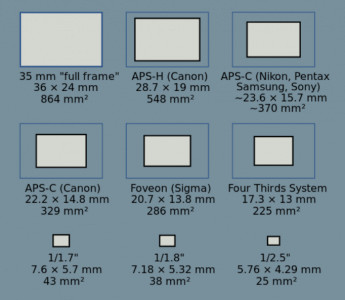 Sensor size comparison illustrating the difference between various camera types
Sensor size comparison illustrating the difference between various camera types
Trade-off: Larger sensors typically mean higher camera prices and larger, heavier lenses.
Full-frame sensors are generally used by professional photographers for their superior image quality and performance, especially in low light.
APS-C sensors are commonly found in consumer DSLRs and larger mirrorless cameras, offering a good balance of size and performance.
Four Thirds sensors are smaller than APS-C but still offer significant advantages over the tiny sensors found in point-and-shoot cameras and smartphones.
Point-and-shoot cameras often use the smallest sensor sizes. For context, the latest iPhone sensors are around 18mm², smaller than all sensor types pictured above, highlighting the considerable leap in sensor size offered by dedicated cameras.
Lens: The Eye of Your Camera
After the sensor, the lens is arguably the most crucial component affecting your photos. However, lens selection involves many trade-offs, especially concerning size and weight, which are critical for travel.
Lenses are pure physics—they bend light to focus it onto the sensor. Generally, larger sensors require larger lenses. While larger sensors are desirable for image quality, the size of the accompanying lenses must be considered, especially for travel.
Trade-off: Lens size and weight are inversely related to zoom capability and lens speed (maximum aperture).
Traveling with extremely large lenses can be impractical.
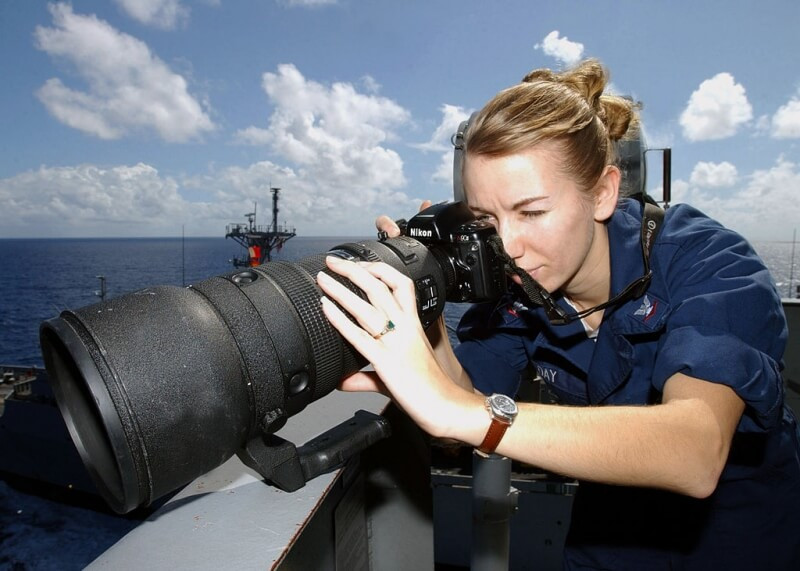 Large telephoto lens demonstrating the trade-off between lens size and zoom
Large telephoto lens demonstrating the trade-off between lens size and zoom
Interchangeable Lenses: Versatility at Your Fingertips
Given the trade-offs associated with lenses, the ability to change lenses is a game-changer. Interchangeable Lens Cameras (ILCs) allow you to choose the right lens for each specific shooting situation.
Trade-off: Carrying more lenses provides greater flexibility but increases overall weight and bulk.
Interchangeable Lens Cameras (ILCs) enable you to select the ideal lens for every photographic opportunity.
Image Stabilization (IS): Sharp Shots on the Go
When traveling, carrying a tripod is often inconvenient. Effective Image Stabilization (IS) can enable you to capture sharp images in situations where you might otherwise need a tripod. While IS won’t eliminate motion blur from moving subjects, it’s invaluable for capturing clear low-light landscapes or cityscapes.
Trade-off: Better IS is typically found in newer and often more expensive cameras. However, the benefits in image sharpness and low-light performance are significant.
Here is a handheld shot of the Boston skyline, demonstrating the effectiveness of image stabilization.
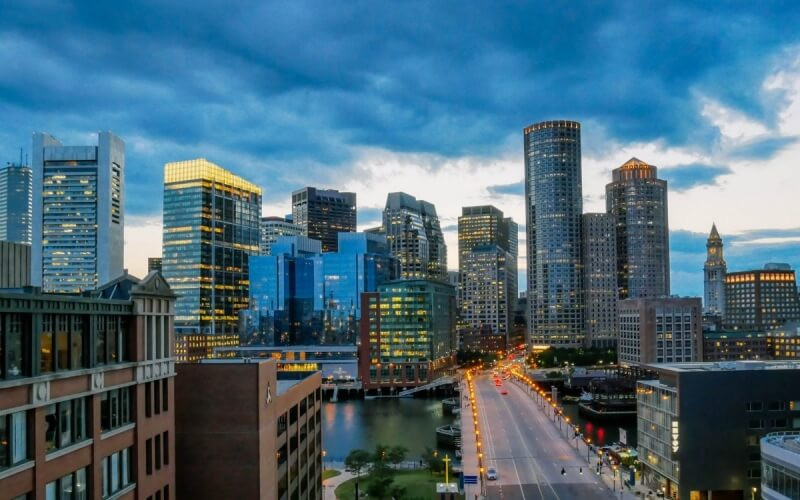 Handheld skyline shot showcasing image stabilization
Handheld skyline shot showcasing image stabilization
Exposure: @ ISO
Focal Length:
Camera:
Date & Time:
Size and Weight: Travel-Friendly Design
While size and weight may be less critical for studio photography, they are paramount for travel. You want a camera that is easy to pack and carry around comfortably. A smaller, more discreet camera setup is also beneficial for security and street photography.
Many people opt for a DSLR but then rarely take it out because of its bulk and weight, leaving it unused at home.
Trade-off: Smaller cameras often come with smaller sensors and fewer features. Components like viewfinders or tilting screens might be omitted. Settings can become less accessible, impacting usability.
Manual Settings: Creative Control
Having manual settings provides significant control over your photography. Even if you initially rely on automatic modes, you’ll eventually want to explore modes like Aperture Priority. Your camera should allow you to easily access and use these manual controls.
Trade-off: Cameras with manual settings typically need physical dials and buttons, which can slightly increase their size. The smallest cameras often bury settings in menus, making them less practical to use quickly.
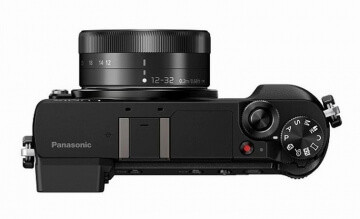 Camera with manual settings dials for quick adjustments
Camera with manual settings dials for quick adjustments
Wireless Capability: Connectivity on the Move
On the road, quickly transferring photos to your phone for sharing is incredibly useful. Wi-Fi or Bluetooth connectivity is essential for modern travel photography workflows.
Trade-off: Newer, pricier cameras typically offer more reliable and faster wireless connectivity. However, even mid-range cameras often include effective wireless features.
Cost: Balancing Budget and Features
While budget might not be a constraint for everyone, it’s a significant consideration for most. Especially with travel gear, there’s always a risk of loss, damage, or theft. For this reason, opting for a mid-range camera rather than the most expensive model can be a prudent choice for travel.
Trade-off: This is subjective and depends on your priorities. Spending more on a camera might mean cutting back on other travel experiences. Conversely, choosing a cheaper camera might compromise on features or image quality, or you might be hesitant to use an expensive camera in risky situations.
Bonus Features: Enhancing Your Travel Photography Experience
Bonus features are the “nice-to-haves” that can significantly improve your travel photography experience. For some, these might even be high priorities.
Video: Most cameras today offer video recording capabilities, ranging from 1080p to 4K. While 4K video might not be essential for still photographers, video image stabilization is a significant advantage, resulting in smoother, more professional-looking videos.
In-camera HDR or Panorama: HDR and panorama modes are standard on smartphones. Having these features built into your camera can streamline your workflow, allowing for more time shooting and less time post-processing.
In-camera features simplify post-processing, allowing you to spend more time behind the camera and less time in front of a computer.
Water and Weatherproofing: Ideally, a camera that can withstand rain or even being dropped in water would be fantastic. However, waterproof and rugged cameras often involve trade-offs in other areas. But for adventure travelers, surfers, or divers, weatherproofing can be a crucial feature.
Portability Enhancements: Small details like USB charging can make a big difference. Being able to charge your camera with a standard micro-USB cable means you can use portable power banks or chargers commonly available, simplifying charging on the go.
The Best Camera For Travel in 2024: Panasonic GX85/GX80
My top recommendation for the best camera for travel currently is the Panasonic Lumix GX85/GX80.
This mirrorless Micro Four Thirds camera with interchangeable lenses strikes an excellent balance of features, performance, and portability. Its rangefinder-style design is both stylish and functional, packed with the right features for travel photography.
Buy the Panasonic Lumix GX85 Now
Let’s examine how the Panasonic GX85 excels in each of the key features we discussed and why it’s my preferred choice for travel, along with a few alternative suggestions for different needs.
Optimal Sensor Size for Travel
The Panasonic GX85 uses a Micro Four Thirds sensor. It’s not the largest sensor available, but it’s significantly larger than those in smartphones and point-and-shoot cameras, offering a great balance. It’s often described as “just right.”
For perspective, the Micro Four Thirds sensor is approximately 13 times larger than an iPhone sensor and about twice the size of sensors in high-end point-and-shoot cameras. This larger sensor area captures substantially more light, leading to superior image quality, especially in varying lighting conditions.
Why not choose an entry-level DSLR or an APS-C mirrorless camera? As a former DSLR user myself, it took time to consider alternatives. But let’s revisit the sensor size comparison. APS-C sensors might not seem drastically larger than Micro Four Thirds at first glance.
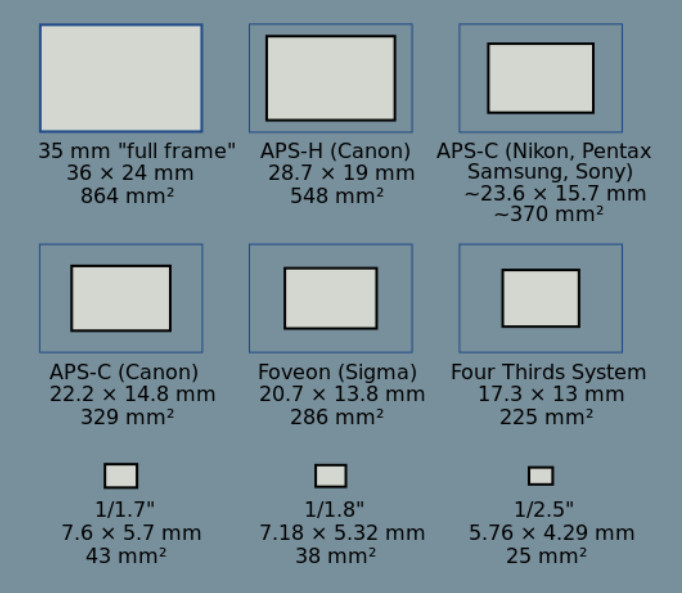 Sensor size comparison chart highlighting Micro Four Thirds sensor
Sensor size comparison chart highlighting Micro Four Thirds sensor
However, this seemingly small difference in sensor size translates to a significant advantage in lens size and weight. Micro Four Thirds lenses are considerably smaller and lighter than comparable DSLR or APS-C mirrorless lenses, making the entire system much more travel-friendly.
This leads us to the next crucial aspect—the lens.
Versatile Lens Options for Every Travel Scenario
If you plan to use just one lens for travel, you’ll want a versatile option that covers a range of shooting situations.
A focal range of 24-70mm (full-frame equivalent) is generally considered highly versatile. This range allows you to effectively capture landscapes, portraits, and even some wildlife that isn’t too distant. You can often “zoom with your feet” within this range.
This focal range is commonly covered by kit lenses that come bundled with many cameras. Even fixed-lens compact cameras like the Canon G7x Mark III offer a similar range, approximately 24-100mm equivalent.
For a visual understanding of different focal lengths, Nikon offers a helpful lens simulator where you can experiment with various lens ranges.
Interchangeable Lenses for Adaptability
But what if your travel plans include a safari where you need to photograph wildlife from a distance? A standard zoom lens won’t suffice for capturing a lion without getting too close. This is where interchangeable lenses become essential.
Think about footwear for different travel scenarios. Would you wear the same pair of shoes for exploring European cobblestone streets, relaxing on Caribbean beaches, and navigating rainy conditions? Likely not. You’d choose 2-3 pairs suited to each environment. Interchangeable Lens Cameras (ILCs) offer the same adaptability for photography.
For everyday exploration, a small, lightweight “walkaround” lens is ideal. Here’s my typical setup for casual travel days:
For low-light photography at night, a fast prime lens excels.
And for dedicated photography days or specific subjects, a larger zoom lens can be used. Here’s how the GX85 transforms with a zoom lens:
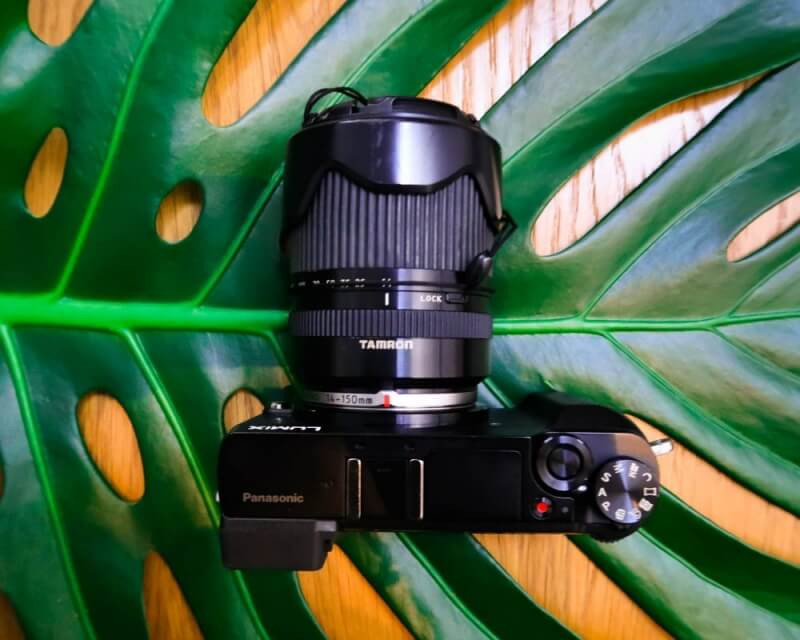 Panasonic GX85 transformed into a DSLR-like setup with a zoom lens
Panasonic GX85 transformed into a DSLR-like setup with a zoom lens
This transformation demonstrates the versatility of an ILC. The GX85 can function as a high-end point-and-shoot for casual use and quickly convert into a more capable, DSLR-like camera when needed.
The Micro Four Thirds (M43) system is among the smallest interchangeable lens systems available. While there is variation depending on specific cameras and lenses, M43 systems generally result in a more compact and lightweight setup compared to equivalent APS-C or full-frame mirrorless or DSLR systems.
The Micro Four Thirds (M43) system is the most compact interchangeable lens system, perfect for travel.
Another advantage of the M43 system is lens compatibility. Olympus and Panasonic collaboratively established the M43 mount standard, meaning you can use lenses from either brand on Panasonic or Olympus M43 cameras. Furthermore, third-party manufacturers like Tamron and Sigma also offer M43 lenses, resulting in a vast selection of over 80 lenses!
If the sheer number of lens choices feels overwhelming, I’ve compiled a list of the best lenses specifically for travel photography within the Micro Four Thirds system.
READ MORE: Feeling overwhelmed by lens choices? Check out my curated shortlist of great micro four thirds lenses for travel photography.
Best Compact Travel Camera
If you know you will realistically never purchase a second lens, a fixed-lens compact camera might be the ideal choice.
My top compact camera recommendation is the Canon G7x Mark III. It’s a fantastic, pocketable camera offering excellent performance at a reasonable price.
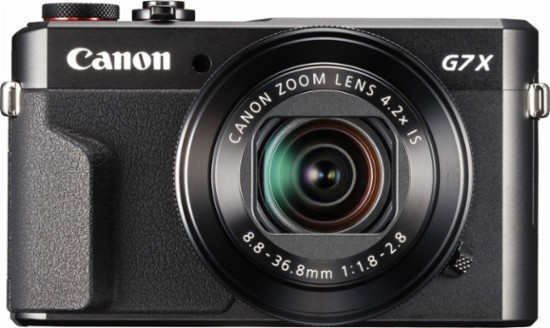 Canon G7x Mark III, the best compact camera for travel
Canon G7x Mark III, the best compact camera for travel
Buy the Canon G7x Mark III now
For a compact camera, the G7x Mark III boasts a large 1-inch sensor—virtually the largest sensor size available in a compact form factor.
Bag Recommendation: Consider a DIY Camera Bag solution to ensure you always have your compact camera with you.
The lens offers a 24-100mm equivalent range and is remarkably fast, with an aperture of f/1.8 at the wide end and f/2.8 at the telephoto end. This makes it excellent for low-light photography and achieving a shallow depth of field for professional-looking portraits.
Wired Magazine described the G7x Mark II (predecessor to Mark III) as “likely to be the best pocket camera Canon has ever produced.”
It features a screen that flips up 180 degrees, perfect for vlogging and selfies.
The G7x Mark III charges via USB, so you don’t need to worry about losing a proprietary charger (although an external charger is also included).
It’s simply a superb and affordable compact travel camera that delivers outstanding image quality in a small package, albeit with a fixed lens.
Portability: Designed for Travel
As discussed, the M43 system inherently offers a smaller overall setup. Within the M43 range, the Panasonic GX85 stands out as particularly compact.
When I purchased the GX85, I intended it to replace my Canon 70D DSLR. However, upon arrival, I was surprised to find it could also replace my point-and-shoot camera due to its incredibly small size.
It includes an electronic viewfinder (EVF), which, while slightly challenging for glasses wearers, is invaluable for composing shots in bright sunlight. It also features an articulating screen, though not 180 degrees, which is useful for shooting from high or low angles, encouraging more creative compositions.
Have you ever found the perfect shot in a bustling market, only to be met with disapproval when raising a large camera? This is another advantage of a smaller camera. Beyond saving precious carry-on space, smaller cameras are more discreet. They are less likely to attract attention in places where “professional cameras” are restricted.
Another travel-friendly feature of the GX85 is its USB charging capability using a standard micro-USB cable. This means you can use any standard USB charger or even a portable power bank to recharge on the go, ensuring you’re never without power.
Advanced Image Stabilization
Image stabilization is a feature you might not realize you need until you experience it. Modern IS technology has become incredibly effective, allowing for handheld shots at surprisingly slow shutter speeds.
The GX85, when paired with stabilized lenses, offers exceptional 5-axis sensor stabilization, providing up to 4 stops of stabilization.
Here is an example of a handheld panorama, showcasing the power of image stabilization.
Exposure: @ ISO
Focal Length:
Camera:
Date & Time:
While it’s hard to quantify precisely, the image stabilization in the GX85 allows me to capture handheld shots that were previously impossible with my older Canon 700D.
Image stabilization technology has advanced dramatically in recent years. Photographers are even capturing handheld shots of the Milky Way!
Full Manual Control
Once you become accustomed to using aperture priority or manual modes, the lack of control in basic cameras can be frustrating.
If a scene is too bright, you need the ability to adjust shutter speed, aperture, or ISO. Nothing is more disappointing than missing a perfect shot because your camera doesn’t provide the necessary manual controls.
Fortunately, the GX85 offers the same level of manual control as a DSLR, with easily accessible dials and buttons for quick settings adjustments. The user interface of a compact camera is crucial for avoiding frustration when you need to change settings rapidly.
This is a primary reason why smartphones can’t fully replace dedicated cameras for serious photographers. Even when manual settings are available on smartphones, they are often cumbersome to access and control. Conversely, if you never use modes like Aperture Priority or Shutter Priority and don’t plan to use different lenses, a smartphone might suffice for your needs.
On-the-Road Sharing
If you don’t share your photos online, wireless connectivity might be less important. Personally, I prefer processing most of my photos in Lightroom before sharing, so it’s not my default workflow. However, during longer trips, posting directly from the road can be convenient.
The Wi-Fi capability on the Panasonic GX85 functions as well as most cameras I’ve used. It can be a bit finicky, but it gets the job done. You can transfer single or multiple photos, in RAW or JPEG format, and even add GPS tags if you’ve enabled the GPS logger before shooting.
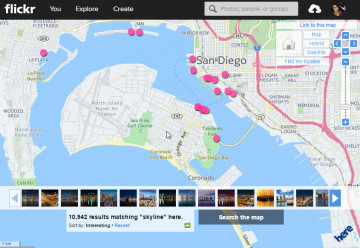 Flickr map showing geotagged photos, illustrating the desire for seamless GPS tagging
Flickr map showing geotagged photos, illustrating the desire for seamless GPS tagging
I wish cameras could seamlessly GPS tag images like smartphones do. Seeing photos plotted on a map is fantastic!
However, GPS functionality is battery-intensive and can struggle to get a quick fix when started in a new location. Until camera manufacturers find a more efficient way to integrate GPS, manual GPS logging using a phone app and syncing later remains the most practical approach.
Nevertheless, the ability to quickly transfer photos and share them on social media while traveling is definitely a valuable feature.
Areas for Improvement
To provide a balanced perspective, let’s discuss some drawbacks of the GX85.
The GX85 is feature-rich, which can sometimes lead to confusion. Enabling certain features can disable others. For example, HDR mode might be unavailable if burst mode, RAW-only capture, or bracketing is enabled. While these limitations are often logical, they can be confusing in the field.
Another minor annoyance is the touchscreen, which can be overly sensitive. I’ve disabled most touchscreen features as a result. Even accidentally touching the LCD with your nose while bringing the camera to your eye can shift the focus point unexpectedly.
While touch functionality can be useful, its implementation could be improved to be more intentional and less prone to accidental activation.
Finally, battery life is not exceptional. I often find myself needing to swap batteries. Carrying a couple of spare batteries is highly recommended.
Cost-Effectiveness
Now, for the price—often the most sensitive aspect. But I’m excited to share this part!
The GX85 is remarkably affordable for a camera in its class. Yes, “in its class” is a common qualifier, but in this case, the GX85 even competes price-wise with cameras in lower classes! For around $700, I purchased the body and two lenses—a 12-32mm pancake lens and a 45-150mm zoom lens.
While deals may vary, the GX85 generally offers exceptional value. You can check the current price on Amazon here.
Wired Magazine simply called this camera “The Best Camera For The Money.”
Historically, a camera feature search on DPReview (sadly no longer available) would highlight only one other camera in this price range with similar features—the Olympus OM-D E-M10, which is older and has a larger DSLR-style format.
The GX85 offers incredible “bang for your buck,” making it the best budget-friendly travel camera available.
A True Gem for Travel Photography
In conclusion, the Panasonic GX85/GX80 is a truly exceptional and budget-friendly travel camera. It meets and exceeds my essential feature list for frequent travelers. Selling my bulky 70D DSLR for this compact camera was a fantastic decision, and I’m extremely happy with the switch.
Note that the GX85 is sold as the GX80 in Europe. There’s also a different camera called the G85. They are not the same. I’ve written a comparison of the G85 and GX85 for those considering both, but it’s important to know they are distinct models.
The Panasonic GX85/GX80 is not only the best mirrorless camera for travel but also my overall top pick for the Best Camera For Travel in 2024.
Ready to make a purchase? Buy the Panasonic Lumix GX85 now
Still unsure about interchangeable lenses? Consider the Canon G7x Mark III, my recommended best compact camera for travel.
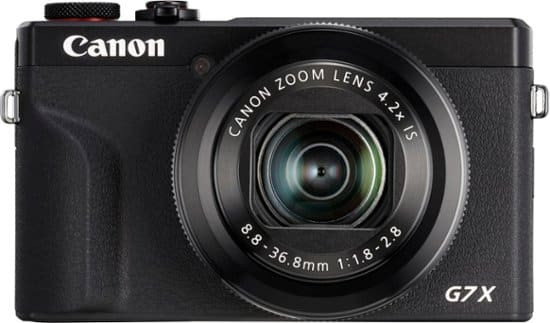 Canon G7x Mark III, best point-and-shoot travel camera
Canon G7x Mark III, best point-and-shoot travel camera
Buy the Canon G7x Mark III now
This post contains affiliate links. As an Amazon Associate, I earn from qualifying purchases. The opinions expressed here are entirely my own.
Essential Accessories for the GX85 Already own the GX85 and looking for accessories? Here’s my list of the best accessories for the GX85.

